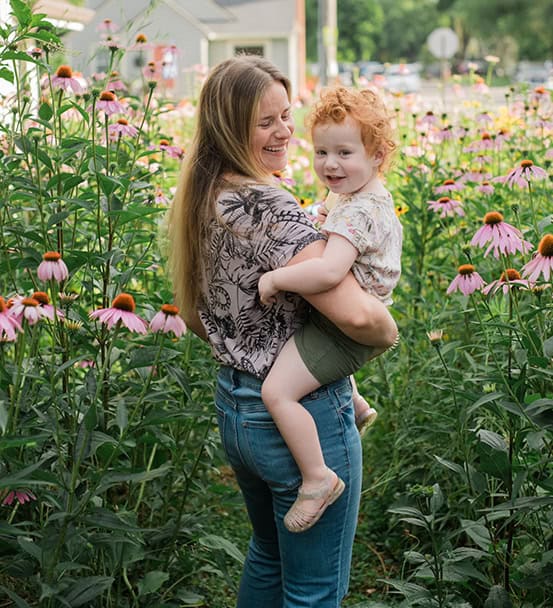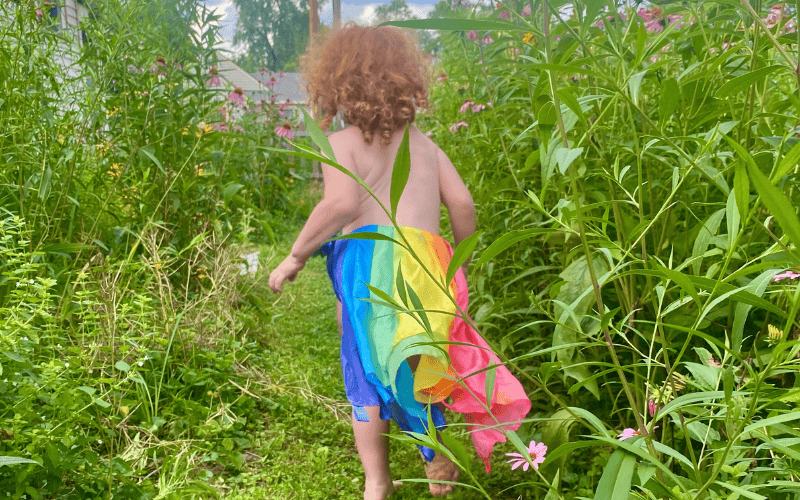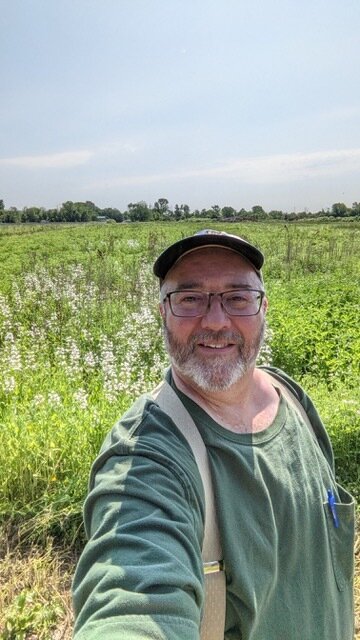This story comes from Hannah Monroe, part of the Homegrown National Park community.
Est. Read Time: 5 minutes
How Motherhood Ignited Creativity and Community
Like many of us during the early days of the pandemic in 2020, I needed a healthy outlet for my overwhelming stress. Gardening seemed to be helpful for other people I knew, so I thought maybe I could grow a few tomatoes like the good Midwesterner I am. Maybe I could cut down on my mowing time and release some stress into the soil while I’m at it. I researched all the ways to kill turf and decided to buy a tarp to solarize about 160 sq ft. That year I planted tomatoes, green beans, peppers, herbs, and garlic. Eating the literal fruits of my labor was enough to get me hooked and want to build more. Little did I know my garden would grow far more than just plants.
When I got pregnant in the summer of 2021, I had a fantasy of walking through a meadow with my daughter when she was born. I could see in my mind’s eye, a blurry vision of her someday running through an explosion of color. Emboldened by a surge of life inside me, building a new human body with my own body, I started to see the world differently. I felt so powerful and creative. My body was full of new life, and I wanted everything near me to reflect that. Here I was, fertile with possibilities, and suddenly my lawn felt so sterile. A question started forming in my mind…what else can I build?
“My first garden was a gift to myself. Then it became a gift to my daughter. Then a gift to my neighborhood and to Mother Nature.”
I learned from my first year that I was more excited by a bee visiting a flower than eating a bell pepper, so I leaned into wildflowers and grasses. My daughter was due in the spring of 2022, and I wanted to come home from the hospital greeted by a chorus of pollinators and swaths of color and texture. A cut bouquet on my dining table would not suffice. I got curious. I researched. I experimented. I threw seed mixtures and watched who came up, who wanted to take over, who worked well together, and who didn’t make it.
In May, right before we brought our daughter home, my once blurry vision exploded into a bright field of wildflowers in my own lawn. Watching the hummingbirds drinking from the delicate Columbines and the Swallowtails visiting the Echinacea blooms gave me peace during an otherwise clunky first few weeks of being a new mom. I wanted to learn the names of everyone in my garden, plant, bird, and insect, so I could one day teach my daughter.
Then the first seedlings of neighborhood and community connection began to take root as well. I had already lived in my house for seven years and knew maybe four people in the neighborhood. My garden felt like a conversational bridge to people. Its stark contrast to most other yards in the area invited curiosity and the desire for more than just a wave. People stopped to talk to me, friendships started, mom groups formed, and belonging to a community deepened. Native insects, animals, and humans alike flock to the meadow. When I started, I knew relatively nothing about biodiversity, why natives are important, what invasive species were, bloom times, cover crops, keystone species or soil types. I just jumped in and learned little by little. Each season I solarized a bit more lawn and observed, took notes, experimented, attended webinars, and read books. Authors like Doug Tallamy, Robin Wall Kimmerer, and Benjamin Vogt gave me technical knowledge as well as philosophical and ethical reasons for the big “Why” of ditching lawns for native habitat. They all shed light on the urgent need to address our planet’s diminishing biodiversity and how everyday people can make a huge difference.
“I want to shout to the world that my daughter deserves a healthy climate, she deserves to see fireflies in June, she deserves to see a caterpillar turn into a butterfly.”
As my daughter has grown, so has the native habitat outside my window. Five years since I began, I have barely any turf left on my 0.14-acre city lot. I started with 160 sq ft and have grown to over 1,100 sq ft. In its place are Monarchs on milkweed, goldfinches on coreopsis, and ruby-throated hummingbirds on trumpet honeysuckle. I now had a full-fledged ecosystem in my yard calling me out every night to observe, weed, and bask in.
I never would have guessed that I would build a statement garden. I didn’t know I had something to say. Now that my daughter is 3, I realize I have something to shout. I want to shout to the world that my daughter deserves a healthy climate, she deserves to see fireflies in June, she deserves to see a caterpillar turn into a butterfly. I felt deeply that the Earth’s health was declining, and I was tired of feeling powerless about it. Along the way, I’ve heard people in my community saying, “I wish I could do that,” so I used my acquired knowledge to help a few friends convert portions of their mowed lawns into pollinator buffets. And those friends talked to their friends, and the seeds of a new small business were planted.
My first garden was a gift to myself. Then it became a gift to my daughter. Then a gift to my neighborhood and to Mother Nature. The gifts it has given back to me are immeasurable: curiosity, community, connection, tranquility. My garden has grown far beyond the original intent down a path I never saw for myself. Becoming a gardener helped me understand how to better care for Mother Earth. Becoming a mother showed me that I am more powerful than I ever believed. Now with my daughter by my side, we are planting new seeds, and someday soon, there will be new flowers and friends. Together, we are building the garden of our dreams.

Hannah Monroe is a native plant gardener, mother, and wife based in Indianapolis. She is passionate about restoring natural landscapes through sustainable gardening practices that support local ecosystems and biodiversity. Balancing family life with her commitment to environmental stewardship, she brings intention and care to both her home and her work in the garden.



Thank you! It is good to find a kindred spirit!